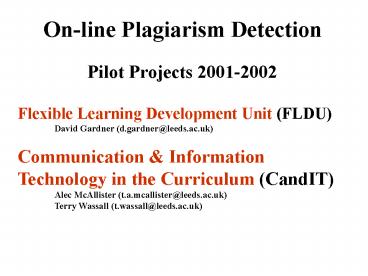Electronic Plagiarism Detection - PowerPoint PPT Presentation
1 / 14
Title:
Electronic Plagiarism Detection
Description:
Communication & Information Technology in the Curriculum (CandIT) ... e.g. disk, email attachment, NBB Pigeon Holes... Copy and paste text only submission process ... – PowerPoint PPT presentation
Number of Views:22
Avg rating:3.0/5.0
Title: Electronic Plagiarism Detection
1
On-line Plagiarism Detection
Pilot Projects 2001-2002
Flexible Learning Development Unit (FLDU) David
Gardner (d.gardner_at_leeds.ac.uk) Communication
Information Technology in the Curriculum
(CandIT) Alec McAllister (t.a.mcallister_at_leeds.ac
.uk) Terry Wassall (t.wassall_at_leeds.ac.uk)
2
On-line Plagiarism Detection
Pilot Projects 2001-2002
- The Context
- The JISC Plagiarism Project
- The Turnitin.com Document Comparison Service
- Turnitin Demonstration
- Current Legal Constraints in using Turnitin
- Current system limitations
- Project Scenarios
- Setting up a Project
- Collecting Project Feedback
- Support and Staff Development
- QsAs
3
Electronic Plagiarism Detection
Context
- Growth of plagiarism from the World Wide Web?
- Growth of student numbers
- Web-wise students
- Increase in assessment load due to modularisation
- Increase in marking loads
- Increase use of essays rather than traditional
examinations - Etc.
- Etc.
4
Electronic Plagiarism Detection
JISC Project http//www.jisc.ac.uk/mle/plagiarism/
- Report of 6 projects using Turnitin.com
- http//www.jisc.ac.uk/pub01/pilot.pdf
- Recommendations for a University plagiarism
policy/strategy - http//www.jisc.ac.uk/pub01/brookes.pdf
- Final report and recommendations for a UK
University service - http//www.jisc.ac.uk/pub01/plagiarism_pilot.pdf
5
The JISC Electronic Plagiarism Detection project
was established to review electronic solutions to
the issue of plagiarism. However, it became
clear that, as with most things in life,
technology can only assist us, it will never
replace the expertise of humans and that the
answer to problems usually lies in process and
procedures not technology alone. Electronic
detection has its place in institutions but the
real solutions lie in appropriate assessment
mechanisms, supportive institutional culture,
clear definitions of plagiarism and policies for
dealing with it and adequate training for staff
and students. If these areas are improved, the
need, desire, and appeal of plagiarism can be
taken away for most students.
6
Electronic Plagiarism Detection
Turnitin.com
- Database of Web documents
- Database stores all uploaded text
- Uploaded texts compared with database
- Reports returned within 24 hours (normally)
- Comparisons identify -
- of identical text
- URL of copied source documents
- Origin and contact of previously submitted text
7
Electronic Plagiarism Detection
Pilot Projects 2001-2002
Legal Constraints
Student permission (recommended form of
words) Complete anonymisation of submitted
texts (use of pseudo SIDs) Student text cannot
be submitted without the above requirements being
met (cannot be used as evidence)
8
Pilot Projects 2001-2002 (Legal Constraints)
Method of obtaining permission will vary
depending on whether the statement is appended to
an existing form the students sign when
submitting work or a new form is created for the
purpose.
9
Electronic Plagiarism Detection
Pilot Projects 2001-2002 (Legal Constraints)
Use of Pseudo SIDs
Using Excel Edit/Fill/Series/Linear/Autofill
10
Electronic Plagiarism Detection
Problems and Limitations
- Arrange a process for student submission of
essays - e.g. disk, email attachment, NBB Pigeon Holes
- Copy and paste text only submission process
- Cannot upload formatted text (i.e. Word
documents) - No batch upload feature
- No Acrobat PDF files in database (but coming
real soon) - Browser limitations on amount of text pasted.
11
Electronic Plagiarism Detection
Pilot Projects Scenarios
Sign up all students on a module and submit all
that give permission. Sign up all students and
submit sample or ad hoc from those that give
permission. Dont sign up students, scrupulously
anonymise submitted text, and submit some/all to
evaluate the system and get a picture of the
extent of plagiarism in student group.
12
Electronic Plagiarism Detection
Registering for a Pilot Project
- Create a personal profile (user name and
password) with Turnitin - Send your user name and department to FLDU
- Attend a staff training session/consultation if
desired - Use the Pilot Project start-up pack and do it
- Use ad hoc support as required (Terry or Alec)
13
Electronic Plagiarism Detection
Feedback from Pilot Projects
- Monitoring of pilot projects and feedback
important - Must conform with strict rules of use
- The need to evaluate the system rigorously
- to make decisions about continuing with Turnitin
- recommendations to JISC for required features
and functionality of proposed UK system
14
Electronic Plagiarism Detection
Pilot Projects 2001-2002
Continuing support/advice
One hour training/consultation sessions ISS
Training Room Level 6 E. C. Stoner Thursdays
8th, 15th, 22nd, and 29th November 1.15 pm to
2.15 pm and 2.30 pm to 3.30pm Book with
r.l.williams_at_adm.leeds.ac.uk Contact Terry
Wassall (t.wassall_at_leeds.ac.uk) or Alec
McAllister (t.a.mcallister_at_leeds.ac.uk).































